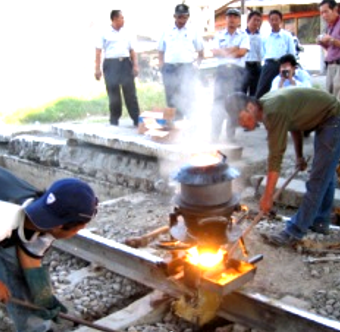Thermite Welding is a welding method that uses chemical reaction heat as a heat source. A welding method that uses chemical reaction heat as a heat source. When welding, the ends of the two workpieces to be welded are fixed in the casting mold in advance, and then a mixture of aluminum powder and iron oxide powder (called Thermite Welding agent) is heated in a crucible to cause an exothermic reaction of reduction to liquid metal (iron) and slag, which is injected into the mold. The liquid metal flows into the joint void to form the weld metal, and the slag floats on the surface. To adjust the temperature of the melt and the chemical composition of the weld metal, an appropriate amount of additives and alloys are often added to the Thermite Welding agent. thermite welding has the characteristics of simple equipment, is easy to use, and does not require a power source, and is commonly used for welding rails, rebar, and other large cross-sectional workpieces.
Other names: fusion thermit weldingthermit fusion welding (English name), pengelasan termit fusi (Indonesian name), saldatura termica a fusione (Italian), soldadura térmica por fusión (Spanish), etc.
Heat source: chemical reaction heat
Advantages: simple equipment, easy to use, etc.
Applications: steel rails, steel bars, etc.
Process principle: chemical reaction of aluminum and copper oxide
Thermite Welding process principle
Thermite Welding is a modern welding process that uses the high temperature generated by the chemical reaction (exothermic reaction) between aluminum and copper oxide to produce a liquid high-copper liquid and aluminum oxide residue and uses the high temperature generated by the exothermic reaction to achieve a high-performance electrical fusion. thermite welding is suitable for the electrical connection of copper and copper, steel and copper, and it does not require external energy or power.
History
Founded at the end of the 19th century, when H. Goldschmidt discovered that aluminum powder and metal oxides can be made to start an exothermic reaction by an external heat source and that once the reaction is complete, it can continue on its own, the general formula for this reaction is
Metal oxide + aluminum (powder) → aluminum oxide + metal + heat
Exothermic fusion welding can mainly weld pure copper, brass, bronze, copper, copper clad steel, pure iron, stainless steel, wrought iron, galvanized steel, cast iron, etc.
Advantages
(1) The current cross-section of the welded joint is equal to that of the wire.
(2) The solder joint is permanent and will not cause high resistance due to loosening or corrosion.
(3) The solder joint is like copper, but tougher than the copper itself, and is not affected by corrosive products.
(4) The solder joint can withstand repeated large inrush (fault) currents many times without degradation.
(5) The welding operation method is simple and easy to learn.
(6) The equipment is lightweight and easy to carry.
(7) welding, no external power or heat source; (8) from the appearance of the verification can be verified.
(8) The quality of welding can be verified from the appearance.
Operation points
(1) factors affecting the welding effect
A good surface of the welded joint is rich and bright, with no pores, or slag, and cut its profile into a whole without pores and defects. The main reason affecting the welding effect is moisture or water, because the mold, welding powder, and the welded object may adsorb moisture, so how to prevent or drive away moisture, is the most important step that must be taken when welding. Another factor affecting the welding effect is the cleanliness of the mold and the welded object, such as the surface of the welded object must be cleared of dust, grease, oxides, or other adhesions to make it clean and bright before welding operations, otherwise, the welded joints will be affected by the conductive properties and mechanical properties. If the residue left in the mold is not completely removed, will cause the surface of the welded joint to be not smooth, not bright. In summary, the main points of attention.
① drive away the water vapor (available torch baking)
②Clean the soldered object
③ Clean the mold
(2) Note when applying the soldering powder
① Each packet of solder powder corresponds to a solder joint, and the brand number of the solder powder needs to correspond to the mold, which needs to be carefully checked before use.
②Solder powder is shipped with multi-layer protection against moisture, but it is recommended that it be stored properly to avoid moisture.
Preparation
(1) Each time before the start of work with a heating tool (torch or drying box) baking dry mold to drive
to remove moisture.
(2) Clean the mold after each use, using a soft brush or another soft object to avoid damaging the mold.
(3) Check the tightness of the contact surface of the mold to prevent the copper liquid from leaking out of the gap during operation.
(4) The die clamp is used to open and close the die. The tightness of the die clamp affects the effect of welding, so please check the die clamp carefully and make appropriate adjustments before starting welding.
(5) The mold is made of graphite, which is fragile and cannot withstand throwing and strong impact. Therefore, do not force solder beyond the size of the mold into the mold, or use hard substances and tools to remove the residue.
